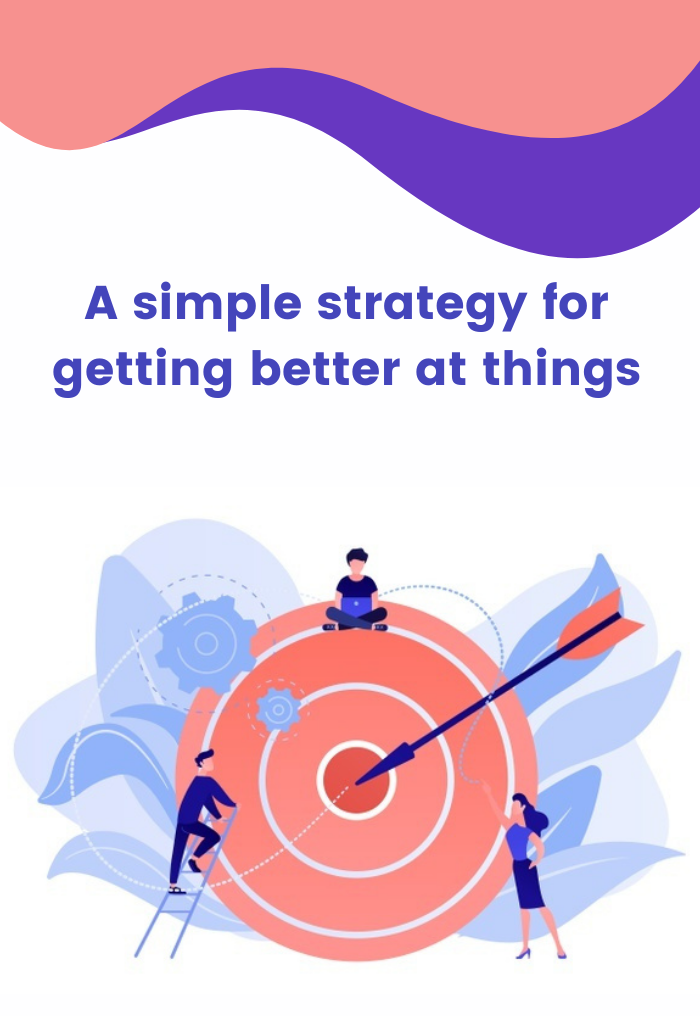A simple strategy for getting better at things

Parent Post
How often do you
How often do you catch yourself saying, “I wish I were better at _____.” Maybe exercising regularly, building relationships, or at work. Maybe you’d like to be more artistic, athletic, or multilingual.
Getting better at things requires work, and you can’t immediately get better at something with a trick or gimmick. Many people don’t improve simply because they don’t know-how.
Here is a simple strategy to get better at anything. Although it requires work, it can help simplify the process of thinking about improvement.
How to get better
How to get better at skills
The best strategy for getting better at skills is deliberate practice. A good way to work on this is to divide it into three parts:
- Practice
- Feedback
- Focus
This is how you can do it.
Step two: FeedbackImproving skills
Step two: Feedback
Improving skills is a loop: first, you attempt something, then you notice how your attempt differs from the ideal, then you adjust what you did and attempt again.
Tighter feedback makes the loop work faster, causing you to learn more rapidly. An absence of feedback can break the loop, causing you to learn slowly or not at all. You can get feedback directly from the environment or by soliciting feedback from other people.
Step three: FocusComplex skills
Step three: Focus
Complex skills are made up of simpler components. Writing is about research, storytelling, description, and organization of ideas. You can accelerate your improvement by focusing on the component skills separately.
This has two effects:
- It allows you to devote more of your cognitive resources to get good at them, allowing you to master the component skills more quickly.
- It lets you spend more time on your weak points, so you can selectively improve whatever is holding you back.
Break down the skill you’re working on into parts. Then make drills that will focus on improving the aspect that you’re missing. Remember to always do some general practice alongside your drills.
Step two: Conditioning the
Step two: Conditioning the habit
The next step is to stick with the behavior long enough that it becomes automatic. This requires effort in the beginning but should become easier until you no longer think about doing it.
Pick an amount of time that seems reasonable. Harder habits are probably better with smaller commitments because they often become easier faster, so you might not start a difficult habit to exercise once every day if you know you have to maintain it perfectly for 90 days, but you might keep it up for 30 days.
Is it a habit
Is it a habit or a skill?
The first step is deciding whether what you’re trying to improve is a habit, skill, or mix of the two.
A good rule of thumb is that if your main problem is with doing something you already know how to do, but doing it consistently, that’s probably a habit. If your main problem is not knowing how to do something well enough, that’s probably a skill.
For example – exercising is a habit, although there is some skill in it too. Speaking another language is a skill. On one hand, reading is a habit—you need to read more. But it’s also a skill—vocabulary, fluency, and subject familiarity all influence how quickly and deeply you can read.
Step three: Maintaining the
Step three: Maintaining the habit
Most habits are metastable. That means that they can endure for a long time, but if something pushes them out of balance they will fall back to an easier behavior. Exercise is an example of a metastable habit because it requires time and energy even if it is automatic for you.
A good rule of thumb is that the commitment should be equal in time to the loss of habit. So if you’ve stopped exercising for a week, you should commit to following your habit for at least a week to get back to an equilibrium. If you’ve stopped for more than two months on a daily habit, you should probably treat it like conditioning a new habit.
Step one: PracticeThe first
Step one: Practice
The first step to get better at something is to use the skill. If you want to get better at writing, you need to write. If you want to get better at speaking a language, you need to speak.
There are two styles you can approach this with:
- Improve the skill via a selected project. This works well for skills that need a lot of time to focus on or that you can’t easily inject into your daily life.
- Treat your practice just like any other habit. Define it clearly, condition it and maintain it. This is most useful when you’re trying to master something over a longer period of time.
How to get better
How to get better at habits
Improving a habit has three main parts:
- Formulating the desired behavior.
- Conditioning the habit.
- Maintaining it once it has formed.
Here’s how to do it.
Step one: Picking the
Step one: Picking the habit
Clearly articulate what you’re trying to improve and replace any ‘Maybe I should be better at something’ with a decision to improve something specific.
A good habit should be something you do regularly. It should happen every day or after a particular trigger (right after work, every time you speak to someone). If it’s a habit of absence (quitting smoking) it should include some concrete alternative to fill the vacuum.
Some examples of vague improvements turned into concrete habits:
- “I need to get in shape.” —> “I’m going to exercise for 30 minutes after work each day.”
- “I should read more.” —> “I’m going to read for 10 minutes before bed every day.”

